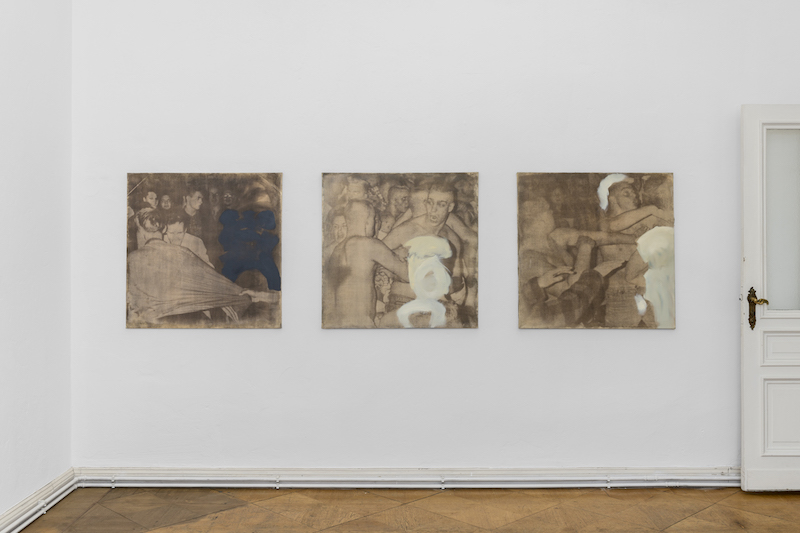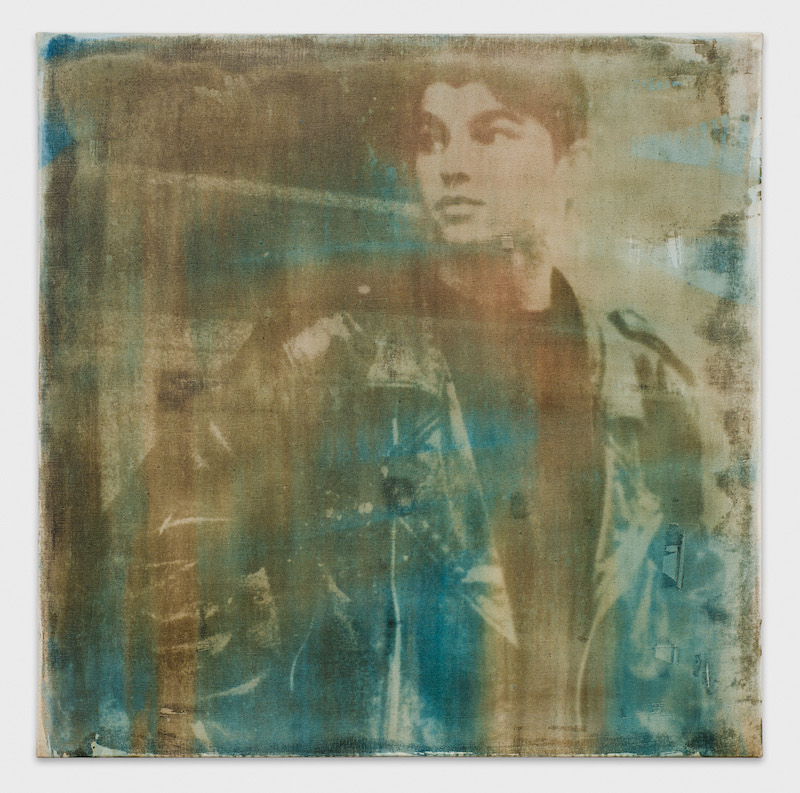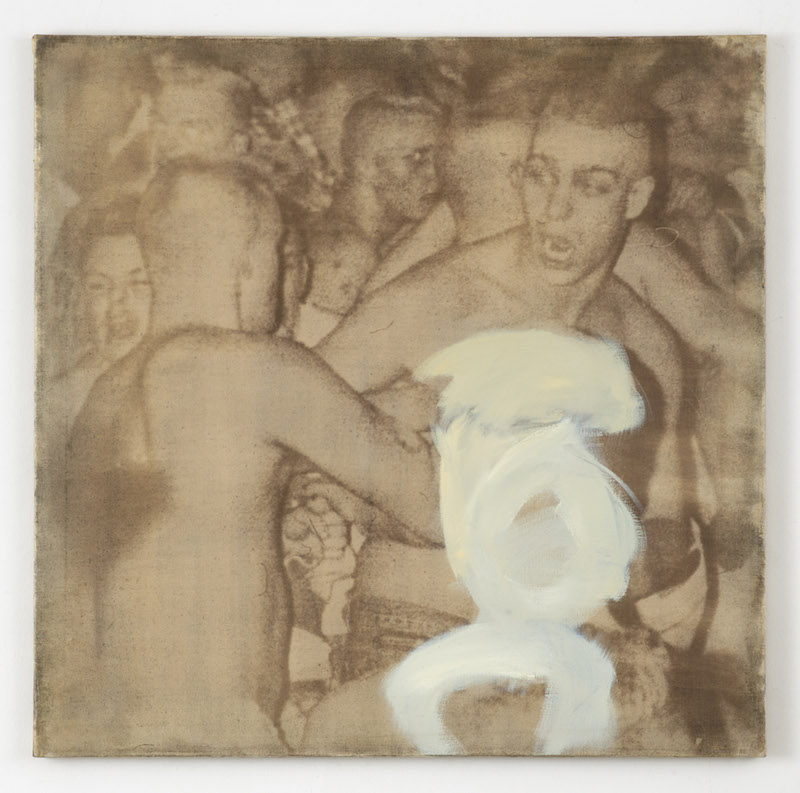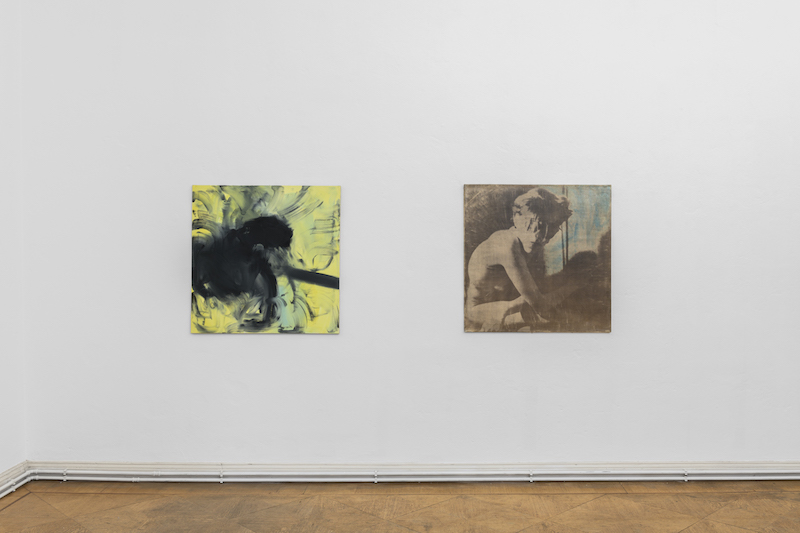by Mats Antonissen // Oct. 15, 2024
The ten square canvasses by German artist Matthias Groebel, currently on view at Schiefe Zähne, although unambiguously dated between 1987 and 1990, appear to inhabit a moment outside of time. A misalignment of their content and form seems to be producing this peculiar effect. Photographs from the 1980s were printed by Groebel on linen, using a 19th century technique. The gap in chronology between subject matter and methodology is conspicuous, because, if nothing else, it inverts the logic of (digital) restoration, a kind of anachronism that the technologies of today have made commonplace, wearisome at times. By flipping the script in ‘chemical’—this Berlin presentation of early work—Groebel provides a fresh, complicating angle on an era whose depictions are readily assumed intelligible and understood.

Matthias Groebel: ‘chemical,’ 2024, installation view at Schiefe Zähne, Berlin // Photo by Julian Blum
The exhibition consists of a set of diverse but familiar visual tropes: still lifes, urban youths and punks in a brawl. To print these images, captured first by the artist with a point-and-shoot camera, the surfaces were covered by emulsified egg white and silver salt, resulting in sepia toned near-monochromes. The liquid was spread with visible carelessness; the men and things are replete with blots, splashes and stray paper scraps. Views break off clumsily at the canvas’ untreated edges and are dotted with pilled fabric—the textile reacting to the treatment or time or both. The series’ reported genesis maps with this amateurish look: a day job at the pharmacy imparted Groebel with the chemical savvy required to prepare the photo-sensitive albumen mix. The brown planes are layered with white, yellow and blue oils: abstract, gestural swirls of paint that approach hairy or floral figuration here and there, or, alternatively, are diluted to a chromatic mist.

Matthias Groebel: ‘Untitled,’ 1990, photo emulsion and toner on canvas, 95×95 cm // Courtesy of the artist
Photographic source material transferred onto painterly supports is the stuff of Groebel’s late-life success. Since 2021, the Cologne-based artist, who is now in his mid-60s, exhibits regularly at national and international galleries of repute; the arguable highlight of this resurgence so far being his retrospective at Düsseldorf’s Kunstverein in 2022. Most of the buzz is generated by the television paintings Groebel made in the 90s. There is something about their formula that is undeniably awe-inspiring: an apparatus was designed and crafted by the artist, through cyber hacking and bricolaging waste, that turns broadcasting pixels into paints and then sprays these colors with a pistol on canvas. Though the color palette of ‘Broadcast Material’ differs from that of ‘chemical,’ it’s evident that all of these were executed by the same, well, hand. Nearly all pieces are 95 x 95cm in size, numbered but nameless, and carry compositions that come across as both thoughtfully measured and casually open-ended at once. Shadows and flaws seem integral to Groebel’s pictures. They are, after all, the spaces where meaning gets to frolic.

Matthias Groebel: ‘Untitled,’ 1987, photo emulsion and oil on canvas, 95×95 cm // Courtesy of the artist
In addition to this impression of spontaneity, a quality most art made outside institutions lets itself ascribe with little resistance, ‘chemical’ also positions itself in the psychic sphere through its method of choice. Using any technology means evoking the ideologies that accompany it, but a process this archaic is a particularly fraught pick. Late 19th century photography, as enabled by the tools for printing in question, was partial to the occult. It was held that spirits could be captured by camera and photos produced by simply looking at a sensitive plate, if the retina had been sufficiently affected by a given scene or sight first. The latter belief was dubbed “thoughtography” and, at the turn of the century, was in vogue from Western-Europe to Japan. A remarkable resemblance exists between some of these supposedly camera-less photographs and what was previously Groebel’s pastime. Besides, try explaining what makes this presentation of painted over photographs as arresting as it is, and parapsychic origins don’t seem that implausible after all.

Matthias Groebel: ‘chemical,’ 2024, installation view at Schiefe Zähne, Berlin // Photo by Julian Blum
Speaking soberly, what makes ‘chemical’ memorable is a combination of a vigorous sensibility, on the one hand, and the significance the work has accrued in the decades gone by since, on the other. With some of these photos, I’m reluctant to accept they are Groebel’s and not sourced from fashion or print. I look at them and think of Cindy Sherman or Calvin Klein; self-consciousness to the point of irony. Maybe my disbelief results from exclusively witnessing the endless riffs and repetitions of an age, never the thing itself. These images are animated by such force, I take it they are from the collective consciousness. A genre of misunderstanding that, I’m assuming, wouldn’t trouble an autodidact much. Matthias Groebel could probably care less if his name is eclipsed by his art.
Exhibition Info
Schiefe Zähne
Matthias Groebel: ‘chemical’
Exhibition: Sept. 13–Nov. 2, 2024
schiefe-zaehne.com
Potsdamer Straße 103, 2. Floor, 10785 Berlin, click here for map



















